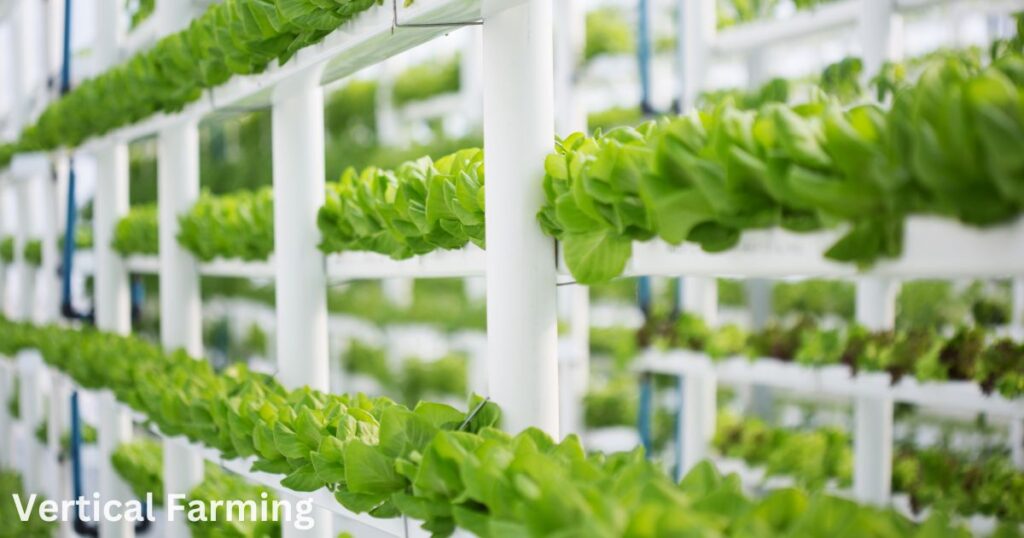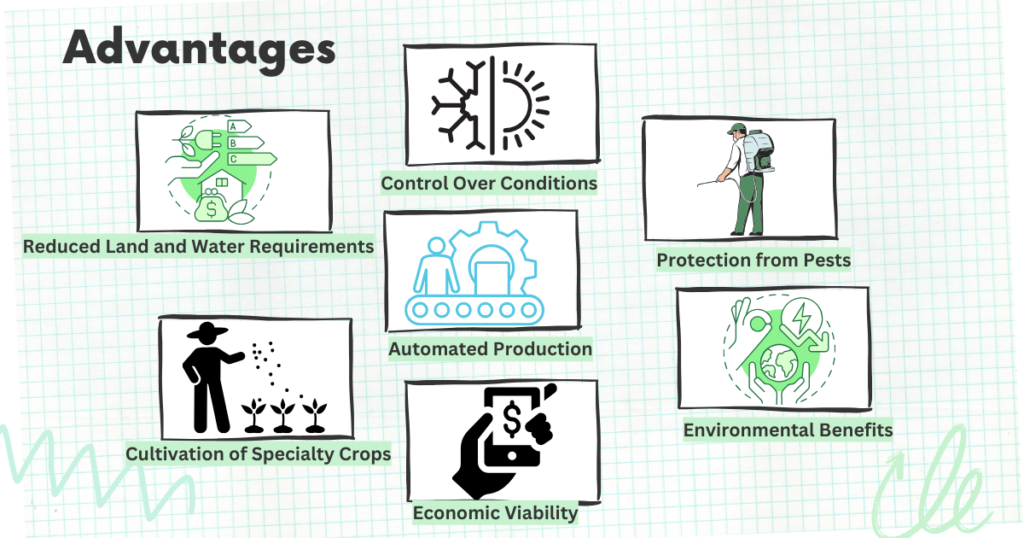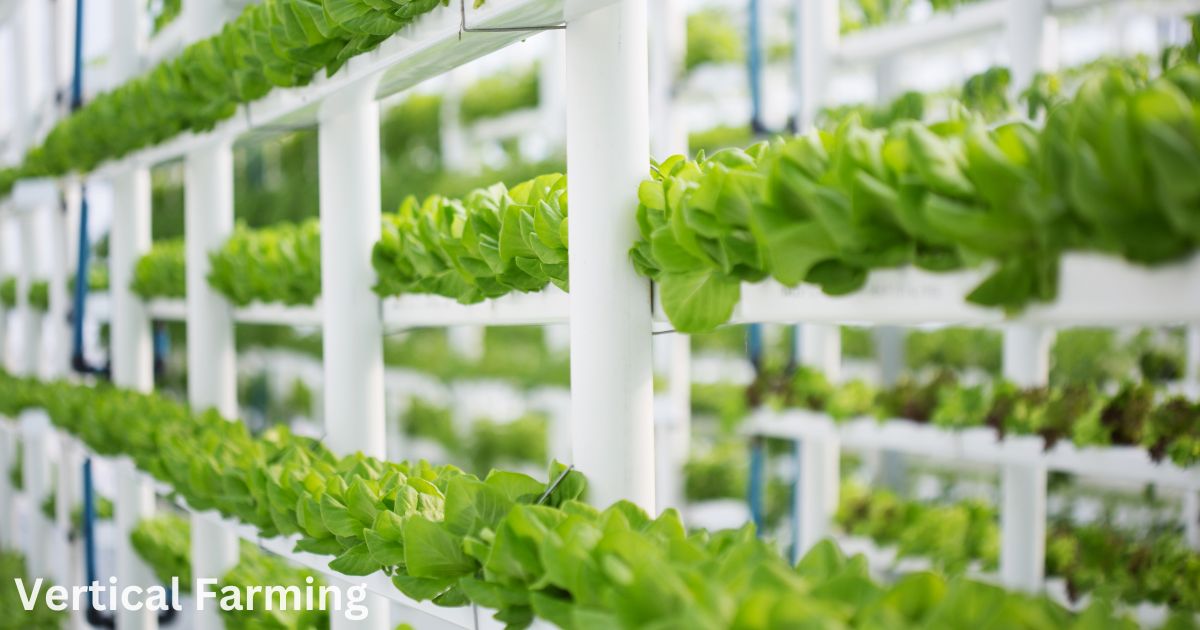As the global population continues to grow and land availability becomes increasingly limited, traditional farming methods face challenges in meeting the rising demand for food. Vertical farming has emerged as a promising solution, offering a transformative approach to agriculture that utilises vertically stacked layers or indoor spaces to cultivate crops.
This innovative technique has gained traction as a sustainable and efficient method for urban agriculture, year-round production, and the cultivation of specialty crops. In this article, we will discuss what vertical farming is, explore the advantages of it, and discuss the future of vertical farming.
What is Vertical Farming?

Vertical farming is an innovative agricultural practise that involves cultivating crops on vertically stacked layers or inclined surfaces, often within controlled indoor environments. This method is designed to maximise space utilisation and efficiency while minimising the need for traditionali soil and outdoor conditions.
In a vertical farming system, various technologies, such as hydroponics, aeroponics, and aquaponics, are employed to deliver nutrients to the plants. These systems often utilise artificial lighting, climate control, and automation to create optimal growing conditions for crops.
The vertical arrangement of crops allows for stacking multiple layers, making it possible to grow a variety of crops in a confined space. This approach is particularly advantageous in urban areas where arable land is limited, enabling local food production and reducing the environmental impact associated with traditional agriculture.
Vertical farming has gained prominence due to its potential to enhance crop yield, conserve resources like water and land, and provide a more sustainable and resilient method of food production in the face of increasing population and urbanisation.
Exploring the Advantages of Vertical Farming
Vertical farming systems offer a multitude of advantages over traditional farming methods, making them a compelling alternative to modern agriculture. Here, we’ve discussed the most important advantages of vertical farming:

- Reduced Land and Water Requirements: Unlike traditional farming, which requires vast expanses of land, vertical farming systems can be established in urban areas, utilising rooftops, warehouses, or dedicated vertical farm structures. This significantly reduces the land footprint required for crop production, making it a viable option for urban environments where land is scarce. Additionally, vertical farming systems employ hydroponic or aeroponic techniques, which conserve water by delivering nutrients directly to plant roots through nutrient-rich solutions or misting systems. This results in significantly reduced water consumption compared to traditional farming methods that rely on rainfall or irrigation systems.
- Improved Control Over Growing Conditions: Vertical farming systems provide growers with unprecedented control over the environment in which their crops are grown. This includes precise control over temperature, humidity, light intensity, and nutrient levels, allowing for optimal growth conditions that maximise yield and quality. By eliminating the unpredictable factors of outdoor weather and pests, vertical farming ensures a consistent and reliable supply of high-quality crops throughout the year.
- Protection from Pests and Diseases: Vertical farming systems offer a closed environment that is isolated from external pests and diseases, eliminating the need for harsh chemical pesticides and herbicides. This results in cleaner, healthier crops that are free from harmful residues. Additionally, the controlled environment allows for the implementation of integrated pest management (IPM) strategies, utilizing natural pest control methods to maintain a healthy crop ecosystem.
- Automated and Efficient Production: Vertical farming systems can be highly automated, minimising labour costs and maximizing production efficiency. Automated systems can handle tasks such as seeding, transplanting, nutrient delivery, pest control, and harvesting, reducing the need for manual labour. This automation, coupled with the controlled environment and efficient use of space, allows vertical farming operations to achieve higher yields per square foot compared to traditional farming methods.
- Cultivation of Specialty Crops: Vertical farming is particularly well-suited for the cultivation of specialty crops, such as herbs, leafy greens, and berries. These crops thrive in the controlled environments of vertical farms, and their shorter growth cycles allow for multiple harvests per year. Additionally, vertical farming can be used to grow crops that are difficult or impossible to cultivate in traditional outdoor settings, such as crops requiring specific temperature or humidity conditions.
- Environmental Benefits: Vertical farming offers several environmental benefits, including reduced greenhouse gas emissions, minimised soil degradation, and improved water conservation. By reducing the need for transportation and refrigeration, vertical farming contributes to a lower carbon footprint for food production. Additionally, the controlled environment and hydroponic systems eliminate soil erosion and contamination, protecting soil health and reducing the impact on surrounding ecosystems.
- Economic Viability: While the initial investment in vertical farming infrastructure can be higher than traditional farming, the long-term economic benefits are promising. Vertical farming’s efficient use of space, high yields, and year-round production can lead to increased profitability and a shorter return on investment. Additionally, vertical farming can create new jobs in urban areas, stimulating local economies and contributing to community development.
The Future of Vertical Farming: A Transformational Approach to Agriculture
Vertical farming, a method of cultivating crops in vertically stacked layers or indoor spaces, has emerged as a transformative agricultural innovation with immense potential to redefine the way we produce food in the future. As technology advances, costs decline, and consumer demand for sustainable and locally sourced produce increases, vertical farming is poised to play an increasingly prominent role in global food systems.
Driving Factors for Vertical Farming’s Growth:
Several factors are driving the growth and adoption of vertical farming:
- Urbanisation and Land Scarcity: As the world’s population urbanises, the demand for local, fresh produce increases while arable land becomes increasingly scarce, making traditional farming methods less feasible in urban centres. Vertical farming offers a solution by utilising vertical space in urban areas, reducing land requirements, and bringing food production closer to consumers.
- Resource Conservation and Sustainability: Vertical farming techniques significantly reduce water consumption compared to traditional agriculture, minimizing the strain on water resources in a world facing water scarcity. Additionally, controlled indoor environments eliminate the need for pesticides and herbicides, promoting sustainable practices and reducing environmental impact.
- Year-Round Production and Climate Resilience: Vertical farming systems offer year-round production, independent of external weather conditions, ensuring a consistent supply of high-quality crops even in regions with harsh climates or unpredictable seasons. This resilience to climate change is crucial for ensuring food security in a changing world.
- Precision Agriculture and Technology Integration: Vertical farming embraces precision agriculture principles, allowing for precise control over environmental parameters such as temperature, humidity, light intensity, and nutrient levels. This optimization leads to enhanced crop yields, improved quality, and reduced resource consumption.
- Consumer Demand for Sustainable and Local Produce: Growing consumer awareness of the environmental and ethical implications of food production has driven demand for sustainable and locally sourced produce. Vertical farming aligns with these preferences by reducing the environmental footprint of food production and bringing cultivation closer to urban consumers.
Read More: Biotechnology: Transforming The World Through Science
Technological Advancements and Cost Reductions:
Technological advancements are playing a crucial role in driving down the costs of vertical farming and making it more economically viable:
- Automated Systems and Robotics: Automation of tasks such as seeding, transplanting, nutrient delivery, pest control, and harvesting significantly reduces labor costs and increases production efficiency. Robotics is also being integrated into vertical farming systems, further enhancing automation and precision.
- LED Lighting Technology: Energy-efficient LED lighting systems are becoming increasingly affordable, reducing the energy consumption associated with vertical farming’s controlled environments. This cost reduction is critical for improving the economic feasibility of vertical farming operations.
- Hydroponic and Aeroponic Systems: Hydroponic and aeroponic techniques, which deliver nutrients directly to plant roots through nutrient-rich solutions or misting systems, are becoming more widely adopted in vertical farming. These methods conserve water and optimize nutrient uptake, enhancing crop yields and reducing waste.
- Data Analytics and Sensor Technologies: Data analytics and sensor technologies are being integrated into vertical farming systems to collect real-time data on crop health, environmental parameters, and resource utilization. This data is used to optimize growing conditions, predict potential problems, and improve overall efficiency.
Future Outlook for Vertical Farming
As vertical farming technology continues to advance and costs decline, its impact on global food systems is expected to grow significantly:
- Urban Agriculture: Vertical farming is expected to become increasingly prevalent in urban areas, providing local, fresh produce to urban populations and reducing the environmental impact of long-distance transportation.
- High-Value Crop Cultivation: Vertical farming is well-suited for cultivating high-value crops such as herbs, leafy greens, and berries, which thrive in controlled environments and have shorter growth cycles, allowing for multiple harvests per year.
- Specialty Crop Production: Vertical farming can be used to grow specialty crops that are difficult or impossible to cultivate in traditional outdoor settings, such as crops requiring specific temperature, humidity, or light conditions.
- Integrated Food Systems: Vertical farming is expected to integrate with other innovative agricultural practices, such as rooftop gardening and community-supported agriculture, to create a more resilient and sustainable food system.
- Global Impact: Vertical farming has the potential to address global food security challenges by providing a reliable and sustainable source of fresh produce in regions with limited land or harsh climates.
In conclusion, vertical farming holds immense potential to revolutionise the way we grow food in the future. Its ability to conserve resources, produce year-round, and provide local, fresh produce aligns with the growing demand for sustainable and ethical food production. As technology advances and costs decline, vertical farming is poised to play a transformative role in addressing global food security challenges and ensuring a more sustainable food system for future generations.

Leave a Reply
You must be logged in to post a comment.